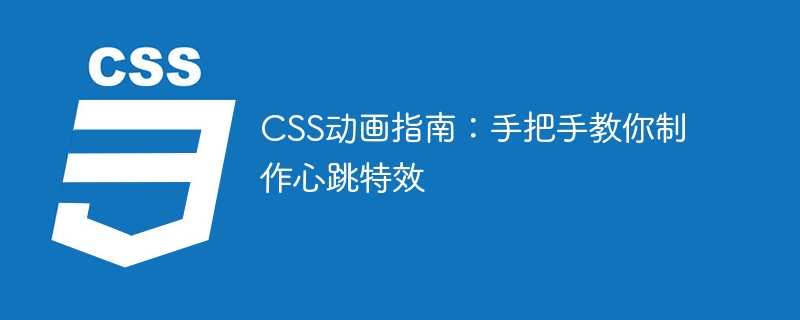

CSS Animation Guide: Teach you step-by-step to create heartbeat special effects
Introduction:
CSS animation is a technology commonly used in web design. It can make static Web page elements present dynamic effects, increasing the user’s interactive experience. Among them, the heartbeat effect is a very popular animation effect, which can make elements appear in a beating rhythm, giving people a lively feeling. In this article, I will introduce you in detail how to use CSS to create a simple heartbeat effect and provide specific code examples.
Step 1: Prepare HTML structure
First, we need to create an HTML file and write the following code in the file:
<!DOCTYPE html>
<html>
<head>
<title>心跳特效示例</title>
<link rel="stylesheet" type="text/css" href="style.css">
</head>
<body>
<div class="heartbeat"></div>
</body>
</html>In the above code, we create a div element and add a class named heartbeat to it. Next, we need to add styles to the CSS file to define this element.
Step 2: Add CSS style
Create a CSS file named style.css in the current directory, and write the following code in the file:
.heartbeat {
width: 100px;
height: 100px;
background-color: red;
border-radius: 50%;
position: absolute;
top: 50%;
left: 50%;
transform: translate(-50%, -50%);
animation: heartbeat 1s ease infinite;
}
@keyframes heartbeat {
0% {
transform: scale(1);
opacity: 1;
}
50% {
transform: scale(1.1);
opacity: 0;
}
100% {
transform: scale(1);
opacity: 1;
}
}In the above code, we first define the style of our heartbeat special effect element through the .heartbeat selector. We set its width and height to 100px and added a red background color and rounded borders to it.
Next, we set the position of this element to absolute through the position attribute, and set it to top and leftproperty aligns it to the center.
Then, we use the transform attribute and the translate function to achieve the central positioning of the element, so that our heartbeat special effect element can be displayed horizontally and vertically in the center of the screen.
Finally, we use the animation property to add an animation effect named heartbeat, and set the duration of the animation to 1 second and the easing function to ease, infinite loop playback. Next, we need to define the keyframe effects of this animation.
In the @keyframes rules, we define the key frames of the animation effect. From 0% to 50% of the time, we animate the element's size and transparency, and from 50% to 100%, we animate the element back to its original size and full opacity.
Step 3: Browser Preview
Now, we only need to open the HTML file we created in the browser to see the heartbeat special effect we created. When we refresh the page, the heartbeat special effect elements will appear in a beating rhythm, giving people the feeling of a beating heart.
Summary:
Through this article, we learned how to use CSS to create a simple heartbeat special effect. We successfully achieved the effect of a beating heart by defining the style of the element and adding animation effects. By learning and mastering the principles and basic techniques of CSS animation, we can apply it to more web designs and provide users with a more vivid and interesting interactive experience. I hope this article can help everyone better understand and apply CSS animation technology.
The above is the detailed content of CSS Animation Guide: Teach you step-by-step to create heartbeat effects. For more information, please follow other related articles on the PHP Chinese website!




